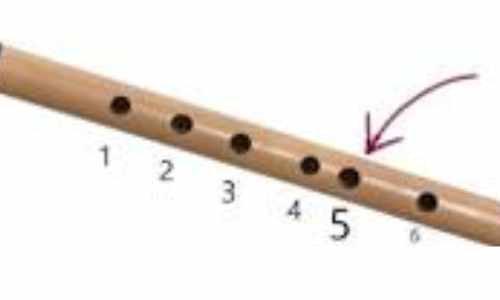Why the 5th hole on Bansuri is bigger than others?
The other day, on our Whatsapp group, we had an enlightening discussion on the question put up by Milind Bhagwat that why the ‘Dha’ hole on all Bansuri is bigger in diameter than other holes?This question coincidentally generated another question as whether the 5th hole is a ‘Dha’ or a ‘Ni’ hole? Here is the answer given by Gopal Rao:
“The hole you refer to – the largest one is NOT called the Dha hole. The largest hole (5th finger hole from top) is called the Ni hole. (4 holes above that hole when closed produces Ni). The Dha hole is the 6th hole from top. Pa has no holes. It is the first note that is produced when we make flutes. All we have is the blowing hole – no other hole has been made. We blow and tune Pa first by cutting off the extra length. When Pa is set – we make the first hole from bottom. That gives Dha. Then above that we make the next hole. This is the largest usually. Produces Ni. Then the hole above that. Produces Sa. (equivalent of of top 3 holes closed but in reality when making the flute we haven’t yet made the top 3 holes as yet). We progress upwards that way till the ma is created.Now lets come back to the original question.
This nomenclature is important to know and be spoken because, if you ever give instructions to a flutier (flute maker – my invented term or flute architect) – you need this nomenclature as he/she understands this terminology. Otherwise they may end up working on the wrong hole.
The tricky part is the 7th hole. In some cases 7th and 8th. This is for lower octave Tivra ma or lower octave Ga. Tricky because, wrong position will disturb Pa. So without disturbing Pa, we need to find the position for the 7th hole. We make a small 1-2 mm hole and keep widening till all notes are correct without compromising any other note production. There are certain ways of checking by tapping certain holes while blowing to know if the positions are accurate or not. A secret I learnt from my Guruji. He, that way, can predict which note will be off without even using a tuner or listening to the flute.”
Before we reached to a logical answer, we had some interesting guesses by other members.
One said, “The real – real reason is – the Ni hole is biggest because we use the middle finger which is the biggest finger – to close it. Simple.” Another one guessed, in a lighter note, “Since we use middle finger which is the biggest finger to close the Ni hole – that hole has to be correspondingly bigger. Otherwise the middle finger will be upset and people will go around showing the upset middle finger to everyone!!!”
But finally, Anil Shah came up with a logical and scientific answer to the question as to why the 5th hole is bigger than others?
As per the laws of Physics, the distance of a finger-hole from the mouth-hole, and the diameter of the finger-hole determines the frequency of the note it plays.As to why the Ni hole is larger, well, you can get the frequency of Ni relative to Sa by either making a bigger hole closet to Sa hole or a smaller hole further down the flute (which would then push the other holes down. So flute maker decide where the blow hole and Pa are and then fit the other holes in.This question does bother many of us and we tend to leave it as it is after failing to find any logical answer. But here, thankfully, we could crack this puzzle through our informal discussion. Hope it enlightens you as well. You can leave your feedback below.
What I marvel at is the skill of artisans thousands of years ago who figured out to place and size flute holes for flutes of various tonic frequencies.
These dimensions are copied by the artisans of today and then fine tuned by listening and sanding the holes to account for different bamboo thickness and quality.
Scientists develop these formulae but flute making is an art and not everything can be precisely calculated.
So we should offer our sincere thanks to these generations of artisans without whom we would not have a well tuned flute.
Post Views: 1,558





